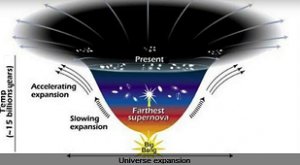
Arquivo para January 26th, 2015
The arrow of time and the universe
 The arrow of time, a term which states that always move forward (in the sense of the time) and that the universe had a beginning the Big Bang, and are expanding, was coined by the astrophysicist Arthur Eddington in 1927, and then used by Stephen Hawking to formulate the theory of the Big Bang, but she has other possibilities.
The arrow of time, a term which states that always move forward (in the sense of the time) and that the universe had a beginning the Big Bang, and are expanding, was coined by the astrophysicist Arthur Eddington in 1927, and then used by Stephen Hawking to formulate the theory of the Big Bang, but she has other possibilities.
Another possibility is the work conducted by Julian Barbour, University of Oxford, Tim Koslowski, University of New Bruswick and Flavio Mercati, the Institute of Theoretical Physics, suggesting that perhaps suggest that gravity is not the thermodynamics, Hawking assumption and many physical, which is the arrow of time forward, this suggests parallel universes, and not a single expanding.
The theory is unifying because the two time paths, gravity pulls the particles to a larger and more orderly model, equivalent to galaxy clusters structures, stars and planetary systems, therefore exceeds the thermodynamic model, which drives only by the amount of energy.
Scientists have made a simulation using thousand particles, similar to a point, and subject to Newtonian gravity in this model there are two future possibilities, but the viewer has the opportunity to “try” just one of them.
This model is still initial and hypothetical, or does not incorporate quantum mechanics and general relativity not, but have open revolutionary and new possibilities.
If the theory is true the Big Bang is not the cosmic beginning, but only a stage in a timeless universe and eternal, explains the scientist Barbour: “This two future situation would display a unique past, chaotic in both directions, which essentially means that there would be two universes, one on each side of this central state, “and so we would always have two possible futures, it philosophically and theologically is true, but the physical needs of experimental certainties and not just hypothetical.
It seems that the whole universe has to make choices and we together with him.

